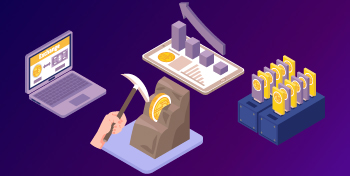In 2021, the world of cryptocurrency was rapidly developing and transforming with the advent of new trends and inventions, but this is only the beginning. Bitcoin, according to Coinmarketrate.com, has reached unprecedented price heights, and the cryptocurrency market has a three trillion capitalization.
Blockchain technology has captured many industries and launched new products. We’ve already seen some trends this year, and here’s what to expect from the cryptocurrency universe in 2022.
Metaverse
No, it’s not just about the new version of Mark Zuckerberg’s Facebook Meta, which will become a networked world of experience straight out of science fiction. Some people think that the metaverse is something like the Matrix world or Ready Player One, but in fact it has some characteristics.
The metaverse must:
- be user-generated content driven by building a world without code, rather than a pre-defined set of realities created by multiple people.
- be a fully functioning economy in which all participants can trade goods and services that have a certain value.
- have content and diverse experiences created by individuals or companies like in the real world.
- be continuous, like a live experience for everyone in the real world, which users can enter at any moment.
- 3D expressions are developed using augmented reality, virtual reality, mixed reality or augmented reality technologies.
While Facebook is going to create its own metaverse, some companies are already implementing its functions. For example, a company called Matterport helps companies digitally take a three-dimensional image of their rooms and place it in the cloud. Customers could virtually visit and explore their favorite stores without leaving home. The online gaming platform Roblox wants to give users and developers the opportunity to create digital worlds. They even already have their own Robux currency.
But what is the connection between the Metaverse and the cryptocurrency world?
Many new platforms, such as DecimalChain (DEL), based on blockchain technology, offer the creation and use of non-interchangeable tokens (NFT) to create, own and monetize innovative decentralized assets and all kinds of items and documentation. Without blockchain technology, the metaverse would be incomplete, since everything would be stored in a centralized network. Thanks to the ability of the blockchain to work on a global scale as a digital source, cryptocurrency makes decentralization possible. The metaverse is different from what the Internet offers today.
Decentaraland is another example of a blockchain metaverse. It is a decentralized 3D virtual reality platform using the Ethereum blockchain. Decentralization will ensure the protection and security of users and allow them to own their data, while cryptocurrencies will allow them to buy and sell goods in the Metaverse.
GameFi
Imagine that you are playing your favorite game and making money from it. GameFi is the place where DeFi meets the gaming sector, or where profitable financial solutions are combined with fun and creativity. Blockchain technology has made great strides in recent years and has given impetus to many new blockchain games. Here are a few popular:
Axie Infinity (market capitalization – $10 billion) is an Ethereum-based game in which users collect, breed and trade fantastic creatures called Axies, such as Pokemon, and earn tokens. It is mainly played by players in the Philippines and Venezuela, as it has a “play to earn” feature.
In the game CryptoBlades, based on the Binance Smart Chain, players earn SKILL tokens by defeating enemies, raiding with friends and winning back winnings.
Most of the currently existing games are quite simple and include NFT in the form of items or characters that can be traded in the game. There is a lot of potential in this sector, and as the next step of development, we can expect many well-known gaming companies to enter the market of other real brands and sell their products, such as clothing or food, as NFT in games.
DAO is a decentralized autonomous organization
Although many believe that DeFi will replace the traditional financial system, and NFT is a new digitized generation of art, the so-called DAO (decentralized autonomous organizations) are gaining popularity, and may become the successors of centralized companies or hierarchies.
DAOs work with blockchain and smart contracts, and are basically organizations whose members jointly invest and manage projects on a decentralized basis. That is, these organizations do not have specific structures, such as corporations, and are not managed by anyone. Instead, management is encoded in smart contracts, and it is difficult to change it.
No one should wait for enough members to vote for a decision. Everything is public and transparent. DAO tokens may even replace the capital of companies in the future, but first they have to solve some regulatory problems.
Here are some examples of well-known DAOs:
- PleasrDAO and Flamingo collect various NFTs and invest in other assets.
- HerStory DAO collects and funds projects of black women and non-binary artists.
- Komorebi DAO collective finances women and founders of non-binary crypto funds.
- MetaCartel Venture DAO is a commercial company that invests in decentralized applications at an early stage and seeks to create a group of venture investments in the structure of the DAO.
NFT and Cryptocurrency
The hype around non-interchangeable tokens (NFT) continues. Even if this is still happening mainly within the cryptocurrency space, if you look closely, you will see a huge potential for the real economy. NFTs will open up new types of trading platforms and digital ecosystems that we don’t know about today. Therefore, it is good to understand the potential and draw possible conclusions from it for your business.
First of all, NFT are cryptocurrency tokens, as well as long-known representatives of Bitcoin, Ethereum and countless others. Coins such as Bitcoin are referred to as “interchangeable tokens”. This means that there are many similar tokens that are interchangeable with each other. No matter what kind of Bitcoin you have, the cost is always the same.
In contrast, NFTs are unique and therefore not interchangeable with each other: each token has its own individual characteristics. For this reason, NFTs are suitable for representing digital goods such as works of art or music, as well as physical goods such as land, cars or automobiles.
In essence, NFT binds a unique physical or digital object to a unique digital token. Thanks to the protected uniqueness and standardization of these tokens, they can now be used in digital business processes, as DecimalChain does. Their NFTs can be used, for example, in digital ecosystems to declare ownership rights to physical goods and to make them available for trade.
NFTs are particularly interesting because of the following properties:
- Guaranteed uniqueness
It is not easy to verify the uniqueness of an object in the physical world, and poses even greater problems for us. NFTs can constantly ensure the uniqueness of a digital object using the basic blockchain technology.
- Protection against counterfeiting
Protection against NFT forgery is also directly related to the blockchain. This property is necessary for trusting business relationships in the digital space.
- Standardization
In order to integrate an object into business processes and make it interchangeable between all ecosystem partners, standardization of its description is necessary. NFTs use standards such as ERC721 to create digital ecosystems.
- Programmability of business processes.
Probably the most important difference from conventional digital objects is the combination of NFT with logic. This became possible thanks to basic smart contracts. This is already used in today’s NFTs, for example, to allow artists to participate in increasing the value in the secondary trade of a work of art. The logic necessary for this is integrated into the NFT and, due to the aforementioned anti-counterfeiting protection, cannot be changed by subsequent owners.
There has been a lot of discussion about the meaning and monetary value of these artistic NFTs. But NFTs offer companies new opportunities to manage and market goods in digital ecosystems. They can bring benefits wherever goods are shared or exchanged between different partners as part of the total value added.
Let’s look at some examples:
- Additional sales in the digital world
In particular, for consumer goods, presence in the digital world is crucial. Instagram, TikTok & Co will in the future become virtual worlds in which companies and their products are present. Virtual analogues of real products (for example, sneakers) can be displayed via NFT. Therefore, the owner of these sneakers also has the right to allow his avatar to wear them.
- Joint economy
Companies jointly purchase a car to use it. The acquisition takes place through a trading platform based on NFT. This gives all companies that have a stake in the machine permission to use it. In a connected SmartContract, the amount of use can be determined depending on the ownership shares. An invoice for use to finance operating expenses can also be generated automatically. Instead of having a responsible intermediary as the owner of the machine, shared ownership of resources is displayed here.
- New financing options
If you combine NFT with decentralized financing (DeFi), completely new forms of financing arise. Real assets, such as cars or land, can be brought to the digital market. With the help of the proof of value provided by the NFT, it is possible to use such forms of financing as co-financing (crowdfunding), securing capital increases or native digital payments.
So, we see that NFT can support business models that connect the analog and digital worlds, as well as support the creation of ecosystems for collaborating partners. In addition, in combination with DeFi, new financing options can be developed that simplify and democratize access to capital, especially for small companies.
Conclusion
Whether in the gaming, art or investment spheres, blockchain technology can be used almost anywhere. Virtual systems are becoming more and more popular, and we see demand for them. Therefore, we should expect an active improvement of the system in the near future, especially if we have the opportunity to make it decentralized and independent.


